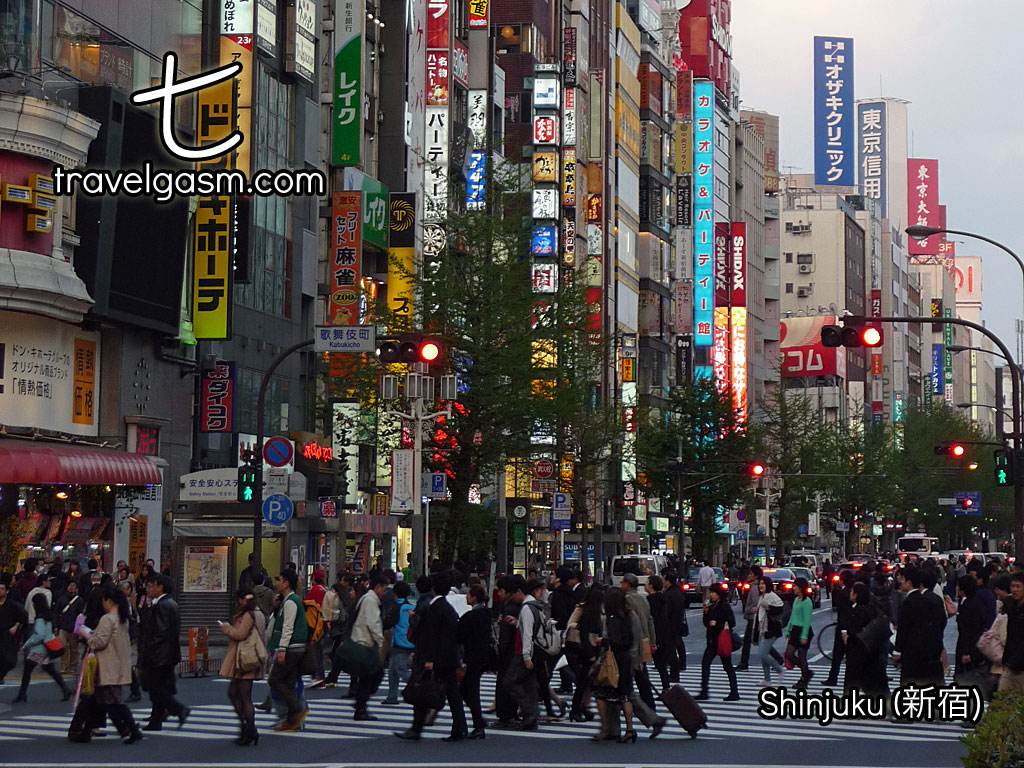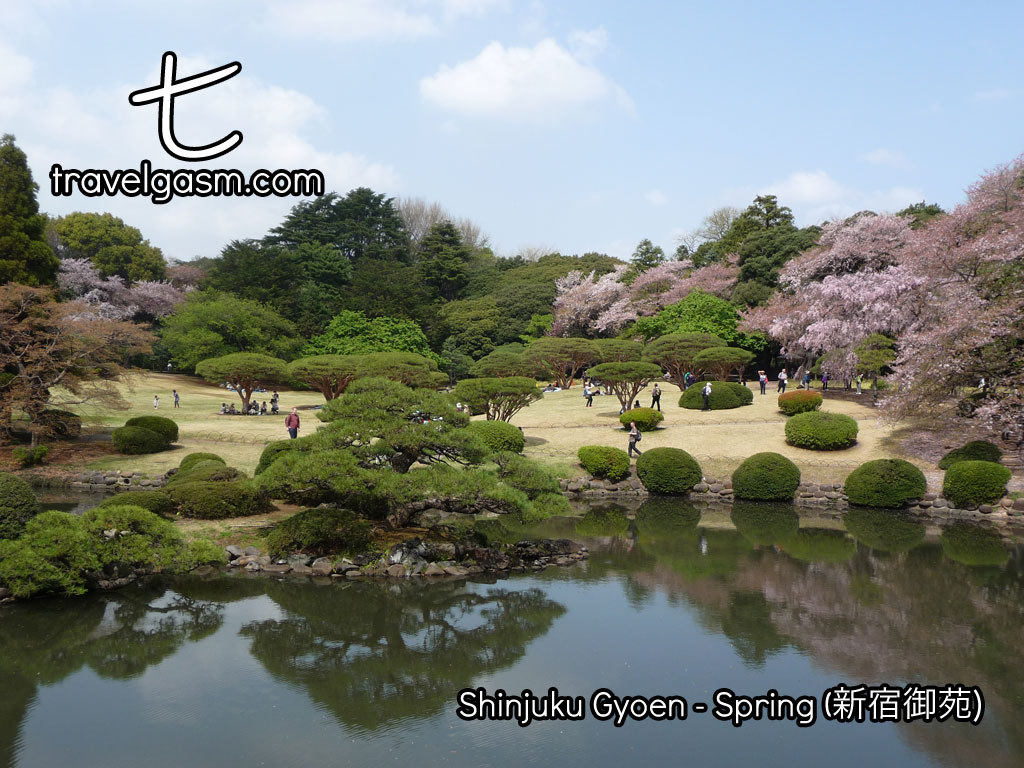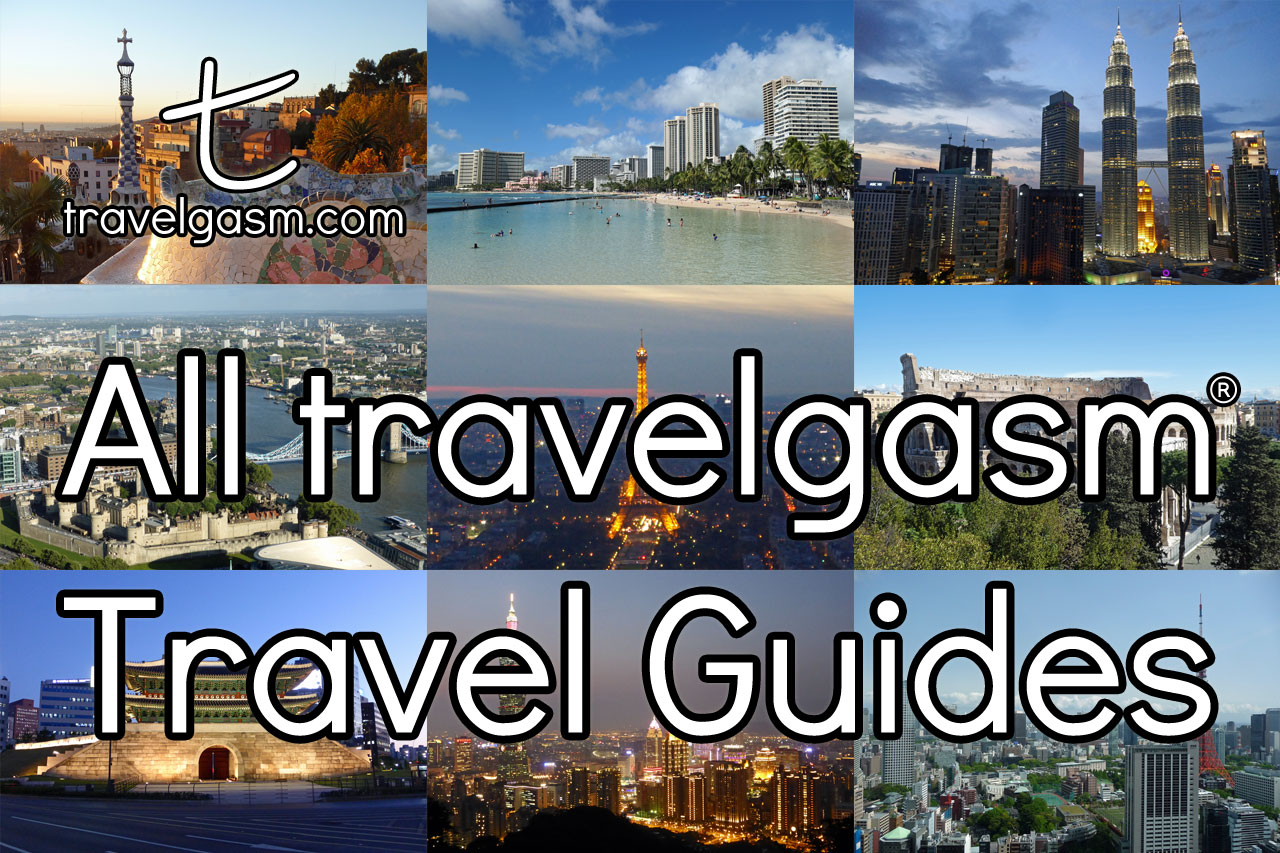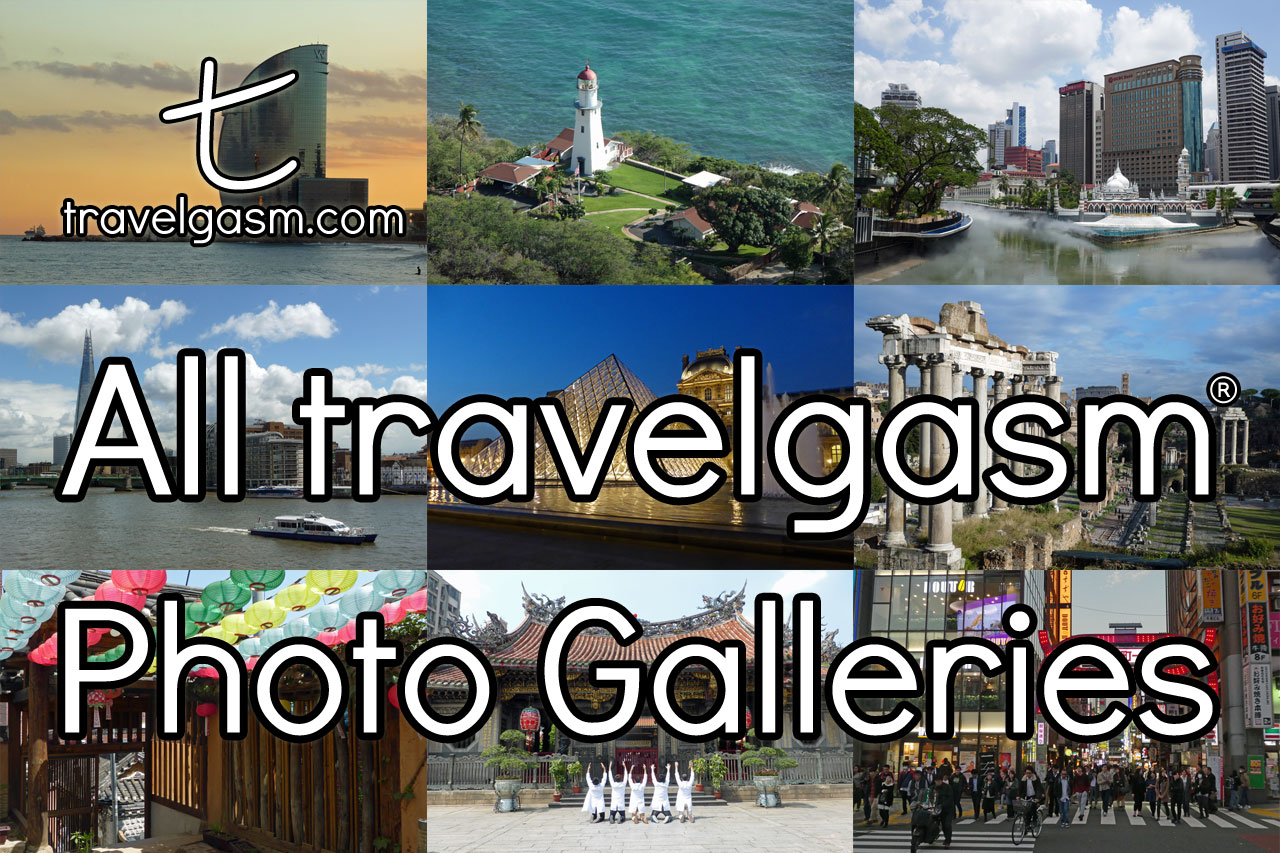Cities > Tokyo > 7 Things Tourists Do in Tokyo That You Should Do Also...
3) Visit Dr. Jekyll and Mr. Hyde
Shinjuku By Day & By Night: Shinjuku Gyoen, Kabukicho, Golden Gai & More

Ringing up more than 1.2 billion passenger journeys per year — with an average of 3.6 million or so per day — Shinjuku (新宿) is the home of the world's busiest train station. It's also a bewilderingly complicated station — with more than 200 exits — so don't feel bad if you get lost on your first visit. Or your second. Or third.
As for the area itself, Shinjuku (新宿) is the Dr. Jekyll and Mr. Hyde neighborhood of Tokyo. Mild-mannered business district by day, notorious — or at least once notorious — red light district by night.
Consequently, travelgasm.com proposes that it is most suitable to organize Shinjuku into two parts. Whether you choose to explore the respectable suit-and-tie Dr. Jekyll during the day or the anything goes Mr. Hyde at night — or both — is up to you.
Shinjuku By Day (Dr. Jekyll)
Although there also is plenty of shopping — perhaps most notably the series of high-end Istean department stores — Shinjuku mostly is known during the day among visitors for its beautiful Shinjuku Gyoen National Garden (新宿御苑).
Finished in 1906 as an imperial garden and rebuilt and opened to the public after WWII, Shinjuku Gyoen hosts beautiful English, French, and Japanese-style gardens and definitely is a must visit. It is perhaps at its most beautiful in the early spring during cherry blossom season, or hanami (花見), and again in the autumn when the leaves change colors, or kouyou (紅葉); but it is lovely year round.
Shinjuku Gyoen has an admission charge for adults of ¥200 (US$1.80/£1.30/€1.50 or so) which seems to discourage just enough tourists to keep it from becoming too crowded. In fact, on multiple morning visits during peak seasons, we found the lines to be minimal. Be sure also to refer to the official opening schedule, as it can vary; but, in general, it opens at 9 AM and closes at 4 PM. Much of the year, it is closed on Mondays.
Another popular day time attraction for tourists in Shinjuku is the free Tokyo Metropolitan Government Building Observatories (東京都庁). The walk from Shinjuku station is long and through uninspiring tunnels, but these twin 45-story towers both have free observation decks with nice views from their top floors. One tower or the other is closed some days of the month, but except for a few days around the end of each year, at least one is open from around 9:30 AM until 10:30 PM.
In Shinjuku, we like to grab a Japanese bento box for lunch (弁当) from one of the women selling them in front of Shinjuku Gyoen or from a nearby convenience store and eat in the park when the weather is nice. You even can leave the park and return once in the same day if you ask at a ticket booth for a re-admission ticket before leaving. If you would prefer a proper sit down meal, we enjoyed the fancy Japanese-style hamburger joint Hamburg Will across the street from the park on one visit, but there are dozens of other restaurants nearby, as well.
Shinjuku By Night (Mr. Hyde)
Although you always can get a drink at the Tokyo Metropolitan Government Building Observatories and watch the sun go down, which obviously would be a safe choice, Shinjuku after hours is all about nightlife.
There literally are thousands of restaurants and bars in this district, but three particular areas of potential interest include Omoide Yokocho (思い出横丁), Kabukicho (歌舞伎町), and Golden Gai (新宿ゴールデン街).
The character of each area is different, and you might choose one or another depending on your desired vibe and your degree of Japanese proficiency:
- Omoide Yokocho: Established in 1956, and literally "Memory Lane" in Japanese, this is a narrow alley with small Izakaya (居酒屋) joints selling assorted meats on a stick, noodles, and snacks to happy hour clientele after work. This alley felt rather local years ago, but with the huge increase in visitors to Tokyo, it has plenty of tourists these days. There is an official vendor map available in Japanese that also may be of interest, but now, most shops with an empty seat will gladly accept yen from anyone. We've never had any trouble here.
- Kabukicho: In its modern incarnation, Kabukicho was established in 1948 as a "cultural district" to be centered around a Japanese-style kabuki (歌舞伎) theater. Unfortunately, the theater never was built, the plans never fully materialized, and by the mid-1980s, it had become a defacto red light district with businesses often run by organized crime syndicates (ヤクザ).
Years ago, we were walking in this area in the afternoon wondering if it was really as bad as its reputation when a phalanx of police officers with shields ran past us, forced their way into a building, and charged inside. Generally, police raids are not a sign of a good neighborhood.
Those days now are long gone, though. In 2011, the police established a station in the neighborhood to reduce influence by crime syndicates; and in 2013, laws were passed to reduce the once rampant and aggressive touting, as well. In 2015, one of the primary streets was remodeled — which unfortunately eliminated the mature street trees — and it was rebranded "Godzilla Road." The massive new Shinjuku Toho Building was built, too. In a sure sign of just how mainstream Shinjuku Toho is, it has a Godzilla head on the building to encourage tourist snapshots. It also holds a mall, bowling alley, movie theater, restaurants, and the upscale Hotel Gracery.
Kabukicho is not quite Disneyland now. There still are plenty of "companion bars" and "sexual harassment clubs" and the like, but if you visit in the early evening, you're unlikely to encounter significant trouble if you do not go looking for it. Furthermore, as a gaijin (外人), unless you are proficient in Japanese and likely have a local introduction, you should assume that any solicitation is more likely to be a scam than a genuine opportunity for the illicit. Avoid any and all touts. Don't carry more money than you can afford to lose.
Kabukicho is a good neighborhood for an evening meal. We once enjoyed Tsukiji Sushiko, on the edge of the district, for an affordable set sushi dinner, and there are hundreds of other restaurants in the area, too.
- Golden Gai: Technically part of Kabukicho, Golden Gai is one block with six narrow alleys holding hundreds of tiny bars, many of which can accommodate only a handful of people at a time. It's one of the few parts of Shinjuku that survived both WWII and subsequent redevelopment. The alleys are grimy and the entire block looks like a fire hazard, but it's definitely distinctive.
A directory of bars in Golden Gai — complete with a map — is available in Japanese, but not all of these places will be welcoming to foreigners. The general rule of thumb for Golden Gai is that if the door is open and there is an English sign and menu, foreigners are welcome. If the door is closed and it doesn't look welcoming, it isn't. The more Japanese you speak, the more options you will have, of course; but three interesting bars known to welcome gaijin include Albatross, which has a cool 1920s vibe; La Jetée, which is centered around vintage French cinema; and NaNa, which plays Flamenco. Basically every bar has its own theme, and as you can tell, the themes can be widely varying and surprising.
In Kabukicho and Golden Gai alike — as well as elsewhere in Tokyo — drinking commonly can be complicated (although it tends to be simpler and more "Western" in Roppongi). In addition to the cost of drinks, naturally; there may be a cover charge or a table or seat charge, there may be drink minimums, there may be time limits or time bonuses or penalties, and some bars simply will not accept foreigners or at least foreigners who do not speak Japanese. Some places may not accept foreigners because they're up to no good (or they think you are up to no good). However, it is at least equally likely that they think trying to explain the system is too complicated and they do not want any potential misunderstandings or disputes. Japanese people tend to dislike conflict. If you're rejected, try not to take it personally. You always can learn some Japanese and try again.
If you would like to experience a genuine night out in Shinjuku — and you don't speak Japanese or have Japanese contacts — you might like to book an organized tour of Omoide Yokocho, Kabukicho, and Golden Gai from a local. It's expensive, but Tokyo nightlife is expensive in general. The tour, though, does include some snacks and two drinks and definitely would make everything much easier for you.
We've mapped out how to get to Dr. Jekyll's preferred daytime attractions — Shinjuku Gyoen and the Tokyo Government Building Observatories — in dark green and how to get to Mr. Hyde's nightlife — Omoide Yokocho, Kabukicho, and Golden Gai — in light green below. As always, we've chosen routes that endeavor to provide the most pleasant path and avoid larger streets when possible.
How to Get Here: Although there also are JR Lines and other private rail lines that connect to Shinjuku, for the purpose of this map, take the Tokyo Metro Marunouchi Line (Red) or the Toei Metro Shinjuku Line (Leaf) or Toei Metro Oedo Line (Magenta) to Shinjuku Station (M08, E01, S01, E27). For Shinjuku Gyoen, you can take the Tokyo Metro Marunouchi Line (Red) to Shinjuku-sanchome Station (M09) and take Exit C1. Or, on foot from Shinjuku Station, you can walk underground all the way to Shinjuku-sanchome Station and leave via Exit A1, which isn't much further away. For the Tokyo Metropolitan Government Buildings, you can take the Toei Metro Oedo Line (Magenta) to Tochomae (E28), Exit A4, or walk underground toward Tochomae and exit before the paid area. For Omoide Yokocho, you can take the Toei Metro Oedo Line (Magenta) to Shinjuku-Nishiguchi Station (E01), Exit D3 (or just walk underground from Shinjuku Station because it is connected and not far). For Kabukicho and Golden Gai, use Shinjuku Station, Exit B10. After leaving Shinjuku Station via Exit B10, our preferred route to either is to enter the Subnade shopping mall via Exit 19 and then leave at Exit 7 for Kabukicho or Exit 15 for Golden Gai.
Cities > Tokyo > Tokyo Best 7 > Next: (4) Marvel at Otaku Central... >>
Like Shinjuku, Shinjuku Gyoen National Garden, Omoide Yokocho, Kabukicho, or Golden Gai? Tell your friends and frenemies on social media that you discovered them first:
Intelligent and good-looking readers of travelgasm.com like you also sign up for our free monthly-ish mailing list.
Live in Tokyo? What tourist attraction do you most like to share with visitors? Spotted anything out-of-date or inaccurately translated? Please tell travelgasm.com. ありがとう. Thanks!




